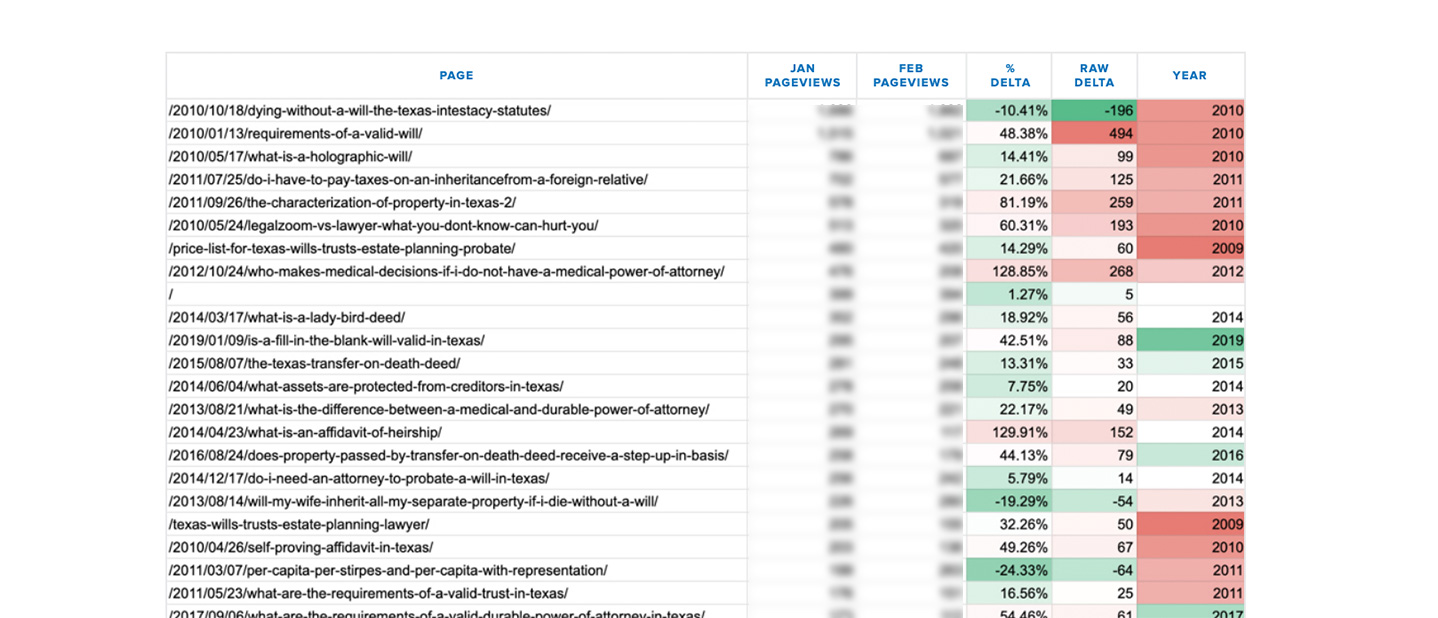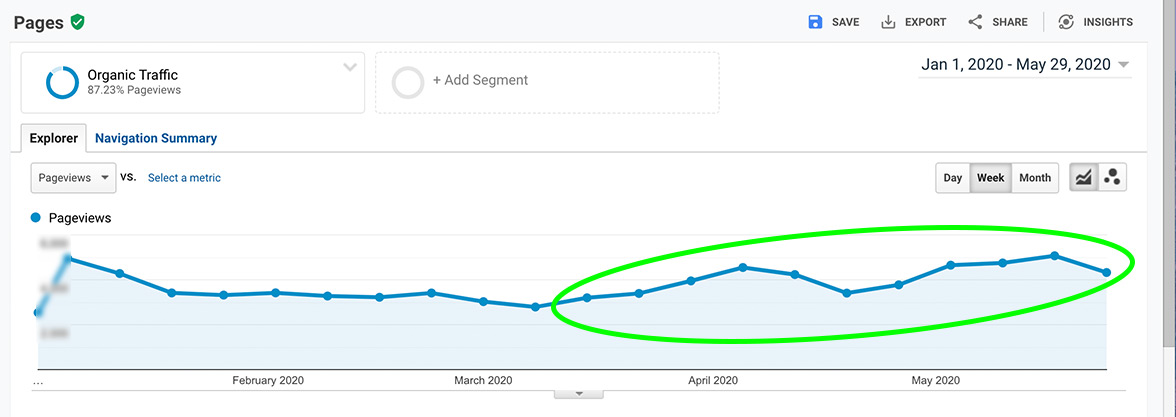It’s safe to say that most websites could benefit from an increased focus on Search Engine Optimization. Search Engine Optimization – SEO, for short – is the science (and art!) of helping your content organically rank higher in Google and other search engines. A well optimized site receives a better position in search results, naturally attracting more visitors and helping your business to win new clients. But like all things, SEO takes time and requires a commitment to identifying and accomplishing goals. Luckily for law firms, some of the best SEO techniques are baked into the work that you’re already doing to keep your firm’s site relevant and up-to-date.
When crawling and indexing websites, Google (and other search engines) generally prioritize high quality content that’s accurate, recent, and easily available. Law firm sites are uniquely situated to excel in these areas because they routinely feature detail-rich content and pages that naturally relate to each other – like a practice area that links to its top-performing lawyers. And considering that attorneys are often gifted in clear communication, the content posted to a firm’s website is likely to be well-written and informative.
By investing just a small amount of time into tweaking your content and monitoring some trends, you can easily take the next step towards attracting organic traffic and improving your site’s performance in search engines.
Law Firm SEO in Practice: A Case Study on a Boutique Law Firm
Earlier this year we completed an SEO project for Rania Combs, a Texas attorney who operates an online-only law firm that specializes in wills and trusts. After seeing a dramatic drop in her site’s traffic, Rania, who was familiar with our law firm website design work, approached us to research, diagnose, and fix the issues that were causing her site’s performance to decline.
Her site was in pretty good shape to begin with, so we began by looking for any technical problems that could explain why the site’s traffic had been on the decline for nearly two years. Rania was already tackling the hardest part of SEO – creating a wealth of deep, valuable content for her audience, so we suspected that there could be some technical issues working behind the scenes to hinder her progress.
Almost immediately, we identified the first source of trouble: a missing XML sitemap.
Why Sitemaps are Essential for SEO
An XML sitemap is basically a guide that points search engines towards your site’s important pages, i.e. the ones worth crawling and indexing. In order to rank well, your content needs to be discoverable by Google and your target audience. The sitemap lists out all of your pages and, when uploaded to Google Search Console, increases the site’s visibility and gives Google an idea of how the site’s navigation is structured.
In Rania’s case, the missing sitemap meant that Google was having a hard time finding content to crawl. And because of this, her site was performing poorly on results pages.
To address the issue we installed Yoast SEO Premium, a WordPress plugin that helps manage SEO tasks like identifying keywords and analyzing readability. Yoast does a lot of other things too, so we used it to generate XML sitemaps for each of the post types on Rania’s website (blog posts, firm news, etc). Next, we submitted the most helpful sitemaps to Google Search Console so that Google would have easy access to all of Rania’s great content.
With the new sitemaps in place, we started to see an increase in traffic right away. But even with one technical problem solved, we knew that there may well be others lurking beneath the surface.
Eliminating Duplicate Content and Pages
Sticking to the technical side, our next move was driven by the discovery that Google had indexed both an HTTP and HTTPS version of each page. This was problematic because duplicate content isn’t great for SEO.
According to SEOPresser, HTTP and HTTPS are most simply defined as protocols that “transfer data from a web server to a browser.” HTTP is not encrypted, meaning that information passing through it can be stolen or compromised by ill-intentioned individuals. HTTPS, on the other hand, contains a secure sockets layer (SSL) that protects sensitive data with an encrypted connection.
There are many advantages to using HTTPS. Most notably, your site visitors feel more secure submitting passwords or payments and Google gives you a small rankings boost for showing a commitment to security.
On Rania’s site, she had unintentionally been using both versions of each page. This mistake was confusing Google, as it didn't know which of the URLs it should be crawling and was suspecting that the site may be full of duplicate content, which is a classic trick of SPAM sites and will lead to penalties from Google.
To address this – and switch her over to the more secure protocol, HTTPS – we created 301 (permanent) redirects from each HTTP page to its HTTPS duplicate. We could then delete the HTTP versions of the pages and pass their link equity to the ones she would use going forward.
After moving to HTTPS and removing the duplicate pages, we were pleased to see that the site’s performance was headed in the right direction – with one caveat.
Being Aware of Google Core Algorithm Updates
When Rania initially reached out to us, one of her biggest concerns was a startling performance drop that took place in January of 2020. She had no idea what was going on, but we realized pretty quickly that her January decline aligned with the release of a Google Core Algorithm update.

Google periodically releases these updates to refine search algorithms so that searchers are met with the best content available. Generally speaking, the updates reward sites that are posting quality material but penalize others that have old or less desirable content.
Rania’s site experienced both effects of the updates. We saw a small decline following the release of Google Core updates in both January and March, but in both cases her traffic ultimately bounced back because she was actively working to make the necessary revisions. In addition, Rania continuously posted new content to her blog that boosted her site’s performance even more.
Even though no one can control or predict what the Core updates will mean for SEO, it’s helpful to be aware that they happen so you can better understand why your site’s performance may fluctuate over time.
Despite the update-related drops, Rania’s progress was encouraging. But we also knew that moving beyond technical improvements would bring even better results for Rania’s firm. To this end, our favorite SEO resource Moz recommended that lost traffic from the update could be remedied by “assessing if your content is well matched to the needs of your visitors, including whether it’s accurate, up to date, and generally written in a way that demonstrates expertise.” This brings us to the next phase of the project: content.
The Importance of Recent Content for Google Rankings
Our next step was to take a closer look at the content on Rania’s site. To do this, we gathered search data on the site’s top 100 ranked pages. While a few of these pages were seeing an increase in pageviews, we noticed the concerning trend that many of the older posts were losing organic traffic at a higher rate than more recent content.

More and more, Google is prioritizing content that is both high quality and recent. This makes sense. Content that was published more recently is more likely to include the latest data or information about a given topic. So even though Rania’s posts were high quality, they were being penalized by the search engine because they hadn’t been updated since they were originally posted 4-10 years ago.
This is a pretty common trap for law firms and all types of businesses that maintain a digital presence. It’s easy to write an awesome blog post, publish it, and move on to the next thing. But every so often, it’s just as important to look through your older content and select a few key pieces to update. We recommended that Rania return to a handful of posts and landing pages that had seen the biggest drops in traffic or impressions.
Refreshing Old Posts with Updates
When updating old content, your goals should be to:
- Increase the depth of the post
- Correct any information that has changed
- Add a brief blurb clarifying when the post was originally published and when it was updated
- Update the “Published” date in your content management system
We were thrilled to see that Rania jumped into the task with enthusiasm and purpose. For each of the old posts we identified, Rania amended the content with new, deeper information, factual updates, relevant internal links, and the requisite line stating the original post date and update date.

As Rania continued to refresh her content, her site’s performance steadily improved even more. She was finally back on track! But even as her traffic trended positive, there was still another issue that caused small dips in the site’s progress.
Removing Toxic Backlinks
That issue was the presence of toxic backlinks.
A backlink can be understood as a link from another website that refers back to your site. For example, a publication like Best Lawyers in America may want to link to your site when recognizing the accomplishments of attorneys at your firm. Because Best Lawyers is a legitimate and well-known site, this would be a high quality backlink that would add to your site’s authority.
While you’d naturally want to gather valuable backlinks from sites like Best Lawyers, you can’t always control who references your content online. This is where toxic backlinks come into play. Unlike a regular backlink, a toxic backlink comes from a spammy site or content farm and can actually harm your site’s SEO. These backlinks are toxic because they associate your legitimate site with the bad reputation of the link’s origin. So if you’re unfortunate enough to accumulate multiple toxic backlinks, Google may interpret your site as less credible and less deserving of a good rank.
When we looked at the backlinks to Rania’s site, we noticed that she had accrued a handful of toxic backlinks. This was likely the cause of a small drop we had noticed in her site’s performance that occurred sometime after she had worked on bringing her content up-to-date.
In order to remove the toxic backlinks, we disavowed them completely. Disavowing a link tells Google that you don’t want anything to do with the spammy site and that the backlink should not be taken into account when your own site is evaluated. Google Search Console includes a disavow tool and instructions that guide site admins through the process of removing backlinks that are harming your SEO.
A Successful Result
After finishing up our SEO work for Rania’s firm, her site has seen a nice increase in organic traffic that shows a complete reversal of the decline that she had been experiencing previously. She’s very pleased with this result and continues to build on our recommendations to further improve her site.

Google released another Core update in May, but because Rania had resolved her site’s technical problems and revised her content, she was rewarded with a rankings bump and yet another increase in organic traffic. Knowing what she knows now, she can better prepare to come away from future updates with rewards instead of penalties.
Takeaways for Other Law Firms Wanting to Improve SEO
For other law firms, the biggest takeaway comes back to content. You’re likely already posting regularly, so make the most of your site by writing pieces that dig deep into each topic, grouping your posts into appropriate categories, and making sure that all of your content is accurate and updated.
One way to approach categorizing posts is by attaching them to relevant people and practice areas. On the law firm website design we created for Young Moore, each practice area page offers links to related attorneys, news items, and resources. Not only is this helpful to clients, but it boosts SEO by increasing the depth of those main practice pages.

Conclusion
If you’re interested in exploring how your firm could benefit from SEO, let’s talk! We would love to collaborate on a digital marketing strategy that would take your site’s performance to the next level. Until then, feel free to leave any questions in the comments below.





Comments
Nadia Nodi
Great post! Law firms face tough online competition, and a smart SEO strategy can make all the difference. We’ve helped legal professionals boost visibility and attract the right clients through focused SEO efforts.Seo Law
SEO law, often referred to as "search engine optimization law," encompasses the legal considerations surrounding the optimization of websites for search engines. This area of law deals with issues such as intellectual property rights, including trademarks and copyrights, and their impact on SEO practices.Sea
It's so impressive. Thank you for sharing this with usLeave a comment